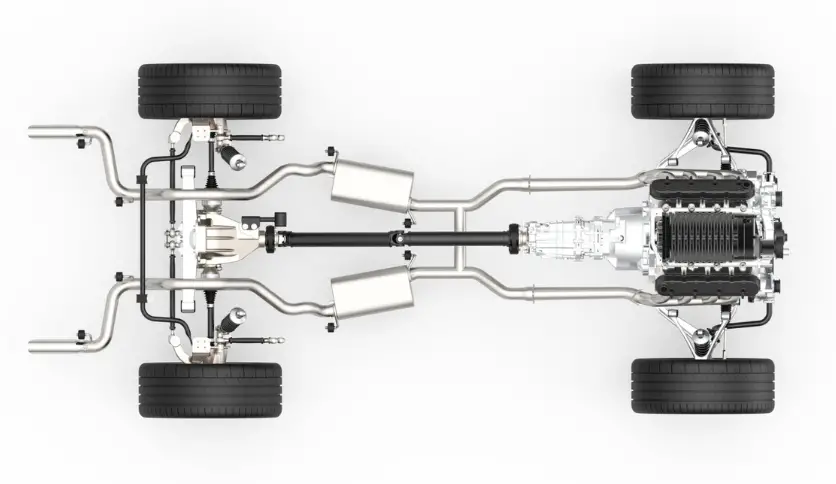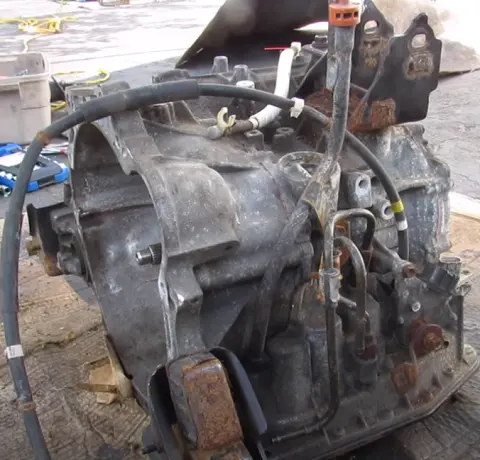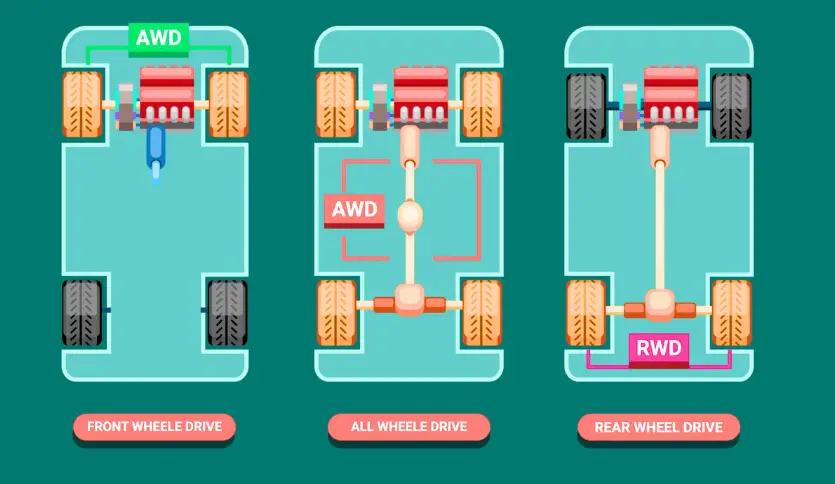Are you thinking of how to convert FWD to RWD? Before making this plan a reality, knowing what you are getting into would be better.
Converting a front-wheel-drive to the rear wheel is no easy task. That will require some knowledge and a lot of money. If you are still up for it, read on because we will describe how the whole process is being done.
Contents
What is a front-wheel-drive (FWD)?
FWD vehicle is defined as a vehicle in which the engine transmits power to the front wheels. The front wheels pull the car while the rear wheels don`t have any power.
The hood of an FWD car is small, and the motor takes up a lot of space. That design can be thanked for the transaxle, which sits just below the engine.
The transaxle is responsible for the transmission and acts as a front differential. The engine sends power to the transmission and to the front differential.
Pros
- They don`t have a transmission tunnel, so there is more interior space
- Light drivetrain results in smaller gas consumption
- The front-positioned engine provides better traction on snow and mud
Cons
- Harder to control in sharp turns
- Performance in uphill conditions is limited, especially on snowy roads
What is rear-wheel drive (RWD)?

RWD car engines are sending power to the rear wheels. That way, the car is being pushed compared to the FWD car pulled forward.
To accomplish that, the car must have components known as a drive shaft and a differential. The engine transmits power to the driveshaft and from there to the differential.
The differential then powers the rear wheels, resulting in the pushing effect. This type of car construction is better suited for performance cars.
Pros
- The balanced weight distribution results in better car handling and brake control.
- Driveline parts are not in the engine space, making the engine more accessible for repairs.
Cons
- RWD vehicles tend to lose traction on frozen and wet roads
- Transmission tunnel reduces indoor space
What does FWD to RWD conversion mean?
There are a lot of car enthusiasts out there who enjoy making changes to well-known cars and, more specifically, converting an FWD to an RWD. Your car may be a great RWD convert. Why not try to make it a rear-wheel-drive powerhouse?
An FWD to RWD conversion is not new; numerous shops and mechanics have been doing it for years. It is a costly and major procedure, but it is a dream come true for a car enthusiast.
To start an FWD to RWD conversion, you must cut a car’s chassis and make a new one. That includes removing everything from the front of the car, including the engine and the transmission.
If you are unsure what type of car you want, here you can see all the differences between an FWD and an RWD.
Material needed to convert FWD to RWD
What we mentioned is just the start. After cutting the chassis and emptying the engine space, you need to build a new frame that will support the new wheel drive.
In most cases, FWD cars have weaker engines, and thinking about swapping them is a must. A usual FWD engine setup is a four-cylinder motor, which can be weak for a car with an RWD.
Replacing it with a V6 or some other option would add much more muscle, making a car a real powerhouse. Here can be viewed as a great example of the conversion of a Honda Accord.
When making this kind of transformation, you will make a unique product with a lot of custom work involved. You will need to make most of the chassis parts from scratch.
Making a transmission tunnel is also a major operation. FWD cars don`t have that tunnel, but it needs to be made when converting to an RWD. That means that the whole floor of the car needs to be redone.
SEE MORE: How To Engage 4 Wheel Drive GMC Sierra
Step-by-Step Guide for How to Convert FWD to RWD
Step 1 – Engine choice and placement
When talking about the engine, the first thing to do is to check the position of the engine. The engine’s orientation can be from right to left or from front to back.
The success of a conversion from an FWD to an RWD will depend greatly on the engine’s position and the transmission.
Changing the engine is not a must, but it is recommended. Since the driveshaft is moving from the front to the back, that demands a serious overhaul of the transmission.
During that work, placing a new, heavier, and stronger engine will give a proper boost. Sticking to the smaller engine while wanting an RWD powerhouse will not get good results.
The thing about an RWD is the punch the car gets from the rear axle, which always comes with a powerful engine.
One of the main reasons for these conversions is how the car lays in sharp turns, and that feeling will not come without a proper boost from the engine.
It can be front, mid, or rear-mounted, depending on the engine type, so making this choice is very important. Maybe the easiest way is by using front-oriented engines because most RWD cars use them.
That way, the weight distribution is better, allowing better handling and braking.
Step 2 – The transmission

When starting a major reconstruction like this, we recommend using an automatic transmission FWD car as a blueprint for a new RWD convert.
The transmission switches from the front to the rear axle when converting from FWD to RWD. Besides that, FWD cars don`t have a transmission tunnel that goes through the vehicle’s floor.
When building a new chassis, making a spot for this is essential.
Also Read: How to Reset Transmission Control Module Chevy Silverado
Step 3 – The suspension
Making a sub-frame for the drive assembly is the next step. The frame should be welded with tubular support to the strut towers and connected with the new frame.
After that, the strut towers should be connected with a removable brace and fitted into the strut tower mouths using bolts.
Installing a toe-adjusted bar used for cars with rear suspension is the big thing in converting from FWD to RWD. It should be placed in the space for the stock power steering back.
When choosing a toe bar, it should be a type that would fit into the stock steerings’ end links.
Step 4 – Cutting the back end of the car
This major conversion cannot be done without major catting of the car’s body. An FWD to RWD conversion requires additional space for the assembly in the back of the vehicle.
Elements of the transmission from the front are moved to the back, so making space in the trunk and the back seats are needed. The wielded subframe must connect the car’s body using custom-made steel plates.
Knowing someone with experience in these conversions could be of great help because they may know how to use a conversion kit for the conversion. That would make this step much easier.
Step 5 – Making a frame for the engine
The conversion is almost done. Making a lightweight frame around the engine is the next step. It should be made from square stock tubing around the engine.
This frame should be covered with plywood that is pressure-treated. Piano hinges are the best way to connect the plywood with the frame. That way, it allows for the best access to an engine.
Choosing plywood is important because it can be a barrier to heat and noise.
Step 6 – Reconnecting everything
The engine, computer, new transmission, AC lines, fuel tank, radiator, and battery must be properly connected. If you added the new shifter or kept the old one, it should be connected with the new transmission.
It can be done by using the universal shifter cable or by connecting the shifter with the extended wires.
FAQ about How to Convert FWD to RWD
Does RWD feel different To FWD?
Yes, RWD (Rear-Wheel Drive) and FWD (Front-Wheel Drive) vehicles feel different. RWD often offers better handling and acceleration, especially in turns, due to the distribution of weight and the way power is applied to the road. On the other hand, FWD cars tend to have better traction in slippery conditions. They are typically more fuel-efficient and space-efficient since the drivetrain components are more compactly arranged.
How hard is it to convert FWD to RWD
Converting a car from front-wheel drive (FWD) to rear-wheel drive (RWD) is complex and costly. It involves significant modifications, including changing the drivetrain layout, transmission, differential, and possibly the vehicle’s chassis and suspension. It’s a labor-intensive project that requires advanced mechanical skills and resources.
01. Can you put an FWD engine into an RWD?
The engine is there to produce power, so it doesn`t matter if it comes from the FWD car. There are a lot of differences in engine orientation and size, but besides that, an engine from an FWD can be put when doing an RWD conversion.
The bigger question is finding a transmission and fitting it into the system. Not all transmissions would work in this combination, so the compatibility needs to be checked.
But there are other questions to be answered when conducting a major car refurbishing as a conversion of an FWD to an RWD. When the engine is adequately oriented, better weight distribution results.
That is a major issue because cars with an RWD can lose balance when aggressively accelerating. Finding an amount that would allow a proper orientation needs to be done.
If the vehicle that will be converted already has a strong engine, that is a bonus. But that is rarely the case. FWD cars are usually fitted with four-cylinder engines with insufficient horsepower.
Swapping it for a V6 or V8 would be a great option. That way, the car would be more fun to drive, which should be the goal of an FWD to RWD conversion.
02. How much does an FWD to RWD conversion can cost?
The cost can vary, but it can easily go to 25.000 dollars. When starting this massive car conversion, you should know that you need these things:
- A lot of time
- A bunch of custom-made parts
- Mechanics that have experience with FWD to RWD conversions
- Enough money to spend
If you want to convert an FWD to RWD, having an RWD donor engine would be best. Yes, you can make the conversion without it, but the results will be even more impressive.
If you don`t have it, you will need to buy it. And buying an RWD engine is not cheap, and will take much of your budget.
Besides the engine, every car that goes through FWD to RWD conversion can be called a unique new car. Making a unique car is always costly because you can never know how many custom parts you need.
Yes, you can buy suspension, transmission, and exhaust and may think you finished the job, but those custom upgrades can cost a little fortune.
Also, finding a team of mechanics who have enough experience to do this job properly is a feat in itself. Not many people are doing these conversions, and those who know what they are doing can cost a pretty penny.
Other factors that can impact the price rise are:
- If the engine is mounted in the wrong direction
- Pairing the transmission from an RWD and an engine from the FWD
- A lot of sensors can be scrambled when making this conversion, so the dashboard can light up like a Christmas tree
- Connecting the gearbox with the transmission
- The lack of parts on the shelf demands a lot of custom-made expensive parts
Verdict
Is switching from FWD to RWD worth the effort? The answer hinges on your aspirations. If a thrilling driving experience and adept cornering are your priorities, this might be worth considering.
First and foremost, possessing an RWD engine from the outset can be a boon. Not only does it curtail expenses, but it also infuses your RWD vehicle with enhanced power and dynamism.
Researching and identifying suitable models for a seamless RWD transformation is wise.
Dive into the availability of necessary components in the market, seek expert opinions from seasoned mechanics, and tally the projected expenses. While we’ve spotlighted a few insightful YouTube tutorials, there’s a wealth of knowledge to tap into.
By absorbing lessons from seasoned converters, you equip yourself to make an informed decision. Ponder over the pros and cons, and if it aligns with your vision, embark on the transformation journey. Relish the revamped drive!

Hello, this is Wesley Shelton, currently working in a car restoration company for over 5 years. Before that, I was a worker at a small car repair shop. As I was a car freak from a young age and worked as a professional for over half a decade, I think I now know pretty much everything about every car and its parts. To establish my name as a professional and help others by sharing my knowledge, I’ve created this website, which I work on whenever I get free time. I hope you’ve enjoyed my informative blog!


